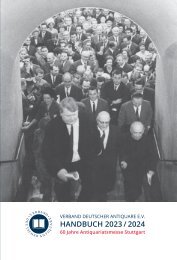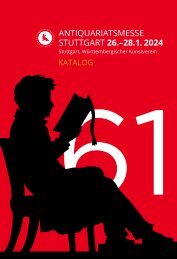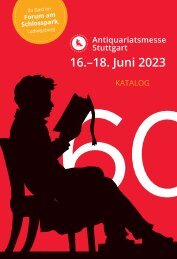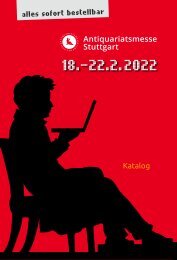Antiquariatsmesse Stuttgart 2021 - Katalog
Katalog zur Antiquariatsmesse Stuttgart 2021: Die Antiquariatsmesse Stuttgart als größtes Schaufenster für wertvolle Objekte des Antiquariats- und Graphikhandels in Deutschland findet in diesem Jahr in ungewohnter Form statt. Da eine Präsenzmesse nicht stattfinden kann, haben sich 76 Kollegen aus Deutschland, Großbritannien, Österreich, Frankreich, der Schweiz, den Niederlanden, den Vereinigten Staaten und aus Australien zusammengefunden, um einen Katalog für die Messe zu erstellen und gleichzeitig ein Angebot für eine virtuelle Messe zusammengetragen. Der Katalog wird am 7. Januar 2021 an interessierte Kunden verschickt, die virtuelle Messe öffnet ihre „digitalen Pforten“ am 29. Januar 2021 um 12.00 Uhr unter www.antiquariatsmesse-stuttgart.de
Katalog zur Antiquariatsmesse Stuttgart 2021: Die Antiquariatsmesse Stuttgart als größtes Schaufenster für wertvolle Objekte des Antiquariats- und Graphikhandels in Deutschland findet in diesem Jahr in ungewohnter Form statt. Da eine Präsenzmesse nicht stattfinden kann, haben sich 76 Kollegen aus Deutschland, Großbritannien, Österreich, Frankreich, der Schweiz, den Niederlanden, den Vereinigten Staaten und aus Australien zusammengefunden, um einen Katalog für die Messe zu erstellen und gleichzeitig ein Angebot für eine virtuelle Messe zusammengetragen.
Der Katalog wird am 7. Januar 2021 an interessierte Kunden verschickt, die virtuelle Messe öffnet ihre „digitalen Pforten“ am 29. Januar 2021 um 12.00 Uhr unter www.antiquariatsmesse-stuttgart.de
Erfolgreiche ePaper selbst erstellen
Machen Sie aus Ihren PDF Publikationen ein blätterbares Flipbook mit unserer einzigartigen Google optimierten e-Paper Software.
The most Famous English Herbal
Gerard, John. The Herball or general Historie
of Plantes. Very much Enlarged and Amended by
Thomas Iohnson Citizen and Apothecarye of London.
London Adam Islip, Ioice Norton and Richard
Whitakers, 1633. Folio, (340 × 230 mm), finely
engraved title and 2776 woodcuts in the text; ll. 19,
including the engraved title, pp. 1630, [50], bound
without both the initial and final blank; engraved
title laid down; p. 1225 with lower corner torn, leading
to loss of 14 lines of text, no loss to image; three
leaves with contemporary hand-colouring; late 18th
century full panelled calf, expertly rebacked and
spine repaired; a very good clean copy. € 3000,–
First edition of Thomas Johnson’s revised and enlarged
edition of Gerard’s Herball (first published 1597), the
most famous of all English herbals. No book on flowers
or trees can be written without quotations from this
remarkable work, the most delightful and refreshing
of all herbals, as it is by far the most amusing. Gerard
essentially takes the reader on a tour of an Elizabethan
garden, and provides an anecdote or story on every
flower, herb or tree. He provides description of plants,
with details of their habitats, alternative names,
and culinary and medical uses, all illustrated
with an abundance of woodcuts.
Gerard’s work was an instant success. It remained
influential until well into the 18th century.
This new edition, revised and expanded
by Thomas Johnson (d. 1644), a London apothecary
and botanist, is regarded as the most
important edition. – STC 11751; Hunt 223;
Nissen 698; Henrey 155.
„prize“ object of made from various substances,
including wood, glass, ceramic, metal, bone, mother-of-pearl,
and lace, and with original silk pouch
retaining the metal roulette ball, and 24 red numbered
tokens; roulette wheel a little faded, „prizes“
delicate and fragile, but all present; in the original
decorative box with hinged lid, with mounted seemingly
hand-coloured lithograph on upper lid, after
a drawing by M.-A. Mourgue; extremities rubbed
and lightly worn; nevertheless, a most appealing
example. € 3750,–
A wonderful and no doubt extremely rare survival, especially
complete as here, of this family parlour game
of „Tombola“, dating from the mid to late 19th century.
Originating in Italy in the 18th century, the game of
„Tombola“ was traditionally a board game similar to
bingo. Here the board has been replaced by a central
roulette wheel, numbered 1 to 24. Presumably a family
member would be elected as „croupier“, with players
either drawing from the bag, or being dealt, one or
more of the red numbered tokens, depending upon
the number of players. The ball would then be thrown
onto the spinning wheel, with the owner of the corresponding
number receiving a prize. The twenty-four
small objects, however, have all been intricately made
and are most charming, even though some are showing
understandable signs of wear. Prizes include two
wooden boxed sets of dominoes, a small worked metal
box, a pocket magnifying glass inlaid with mother-ofpearl
(though missing to edging pieces), an embroidered
doily, a ceramic candle holder in the shape of a leaf, a
pair of cufflinks, a pair of turquoise earrings (again
showing signs of wear), two sets of bone skittles, a
faux tortoise-shell box containing a ring, two painted
ceramic boxes, two small glass candleholders with fake
candles (both of which have broken off), a miniature
mother-of-pearl penknife, and a delightful trinket in
the shape of a metal goat pulling a mother-of-pearl shell
carriage. A delightful „box of delights“, transporting
us back to halcyon days of family games evening – and
perfect for the new lock down world.
Late 19th Century Parlour Game
[Games] – Tombola. Lith. Marie, Paris.
Coqueret Ed. M. A. Mourgue del. [Paris, n.
d. but ca. 1860.] Large decorative cardboard
box (345 × 445 × 65 mm), interior compartmentalised,
housing a wooden roulette
wheel, surrounded by 24 smaller rectangular
boxes, each containing a small ornate
241






